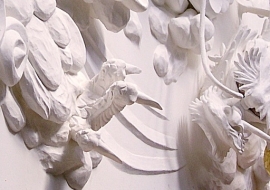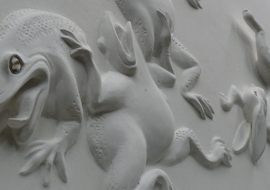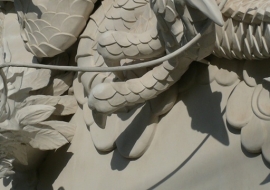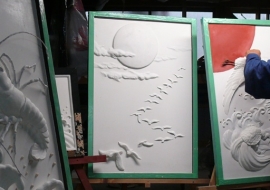A kote-e sculptor who carves the proof of life is right
Bringing Edo-era technology to the present day
If we describe kote-e in simple terms, it is the technique used by a plasterer to create pictures and patterns in relief on a plaster wall by applying plaster with a plastering trowel. In other words, a kote-e is a relief carving created by the skilful use of a plastering trowel.
It is said that the kote-e art form was first thought up by the master plasterer Chohachi Irie, known as Chohachi of Izu, who was born in Matsuzaki, Shizuoka Prefecture in the late Edo era. As Japan entered the Meiji era, Chohachi’s followers spread his technique to various areas throughout Japan. Now that plaster is no longer being used and building materials and architectural styles have changed, the number of plasterers who can create kote-e has decreased to only a few.
However, there is one person who has added his own sensitivity and skills to the technique developed by Chohachi of Izu. That person is Mr. Goro Goto, a kote-e sculptor from Bungo.
Kote-e is something to which I will devote the rest of my life
Mr. Goto, who owned a construction industry company in Oita City, began creating kote-e in earnest when was 42. That was around 10 years ago.
“The changes in the housing situation also cause changes in the way that exterior and interior surfaces are handled. When I was around 30 years of age, I felt that the demand for traditional plasterers would decrease as a result of the spread of factory pre-cut timber and the two-by-four construction method. That was when I began studying kite-e, a Japanese folkcraft and traditional art form, with a view to making that my next job.”
 When he came to on a hospital bed, he realized that by some miracle he had survived the accident. One day during this period when he continued to run his plastering business while meeting the challenges of studying kote-e, an unexpected event occurred. One of Mr. Goto’s interests was piloting a plane that he had built himself, and on that day his plane stalled while he was enjoying his stroll through the sky. The plane crashed with Mr. Goto still on board.
When he came to on a hospital bed, he realized that by some miracle he had survived the accident. One day during this period when he continued to run his plastering business while meeting the challenges of studying kote-e, an unexpected event occurred. One of Mr. Goto’s interests was piloting a plane that he had built himself, and on that day his plane stalled while he was enjoying his stroll through the sky. The plane crashed with Mr. Goto still on board.
“First of all I was thankful that my life had been saved. I then prayed to Buddha that I would be able to walk again. If I became able to walk again, I vowed that this time I would not study kote-e halfheartedly, but would devote my life to it.”
A requiem to war and missionary work with a view to the future. In the end, thanks to his doctor’s strenuous treatment, Mr. Goto escaped amputation and regained the use of his legs. However, his view of life had taken an about-face. “My sense of values changed. Through my own body I learned that a person’s life can end in an instant. If we plan to do something but then don’t do it there is a lingering regret. My kote-e are proof that I am alive.” Mr. Goto’s kote-e are almost three-dimensional. The pictures of dragons with balls grasped in their claws dancing through the air and glaring at the world of men, of the immortal Firebird Goddess in flight and of the Seven Gods of Good Fortune created in his own unique style leap out at you more than those created by Chohachi. The sheer strength that overwhelms one when you look at his kote-e emanates from the spirit that Mr. Goto has carved into each of his works. He is considering incorporating this technique into contemporary buildings, as well as developing it into objets d’art for the facades of retail stores. In order to do this, he says that first of all he needs to have designers and other architecture-related people understand this new type of kote-e.
“It is my dream to pass kote-e on to the next generation, and, if possible, to build pagodas as memorials to all the victims of war on both sides caused by battles such as the Battle of Imphal. I would like to make a contribution to society that will benefit mankind.”







